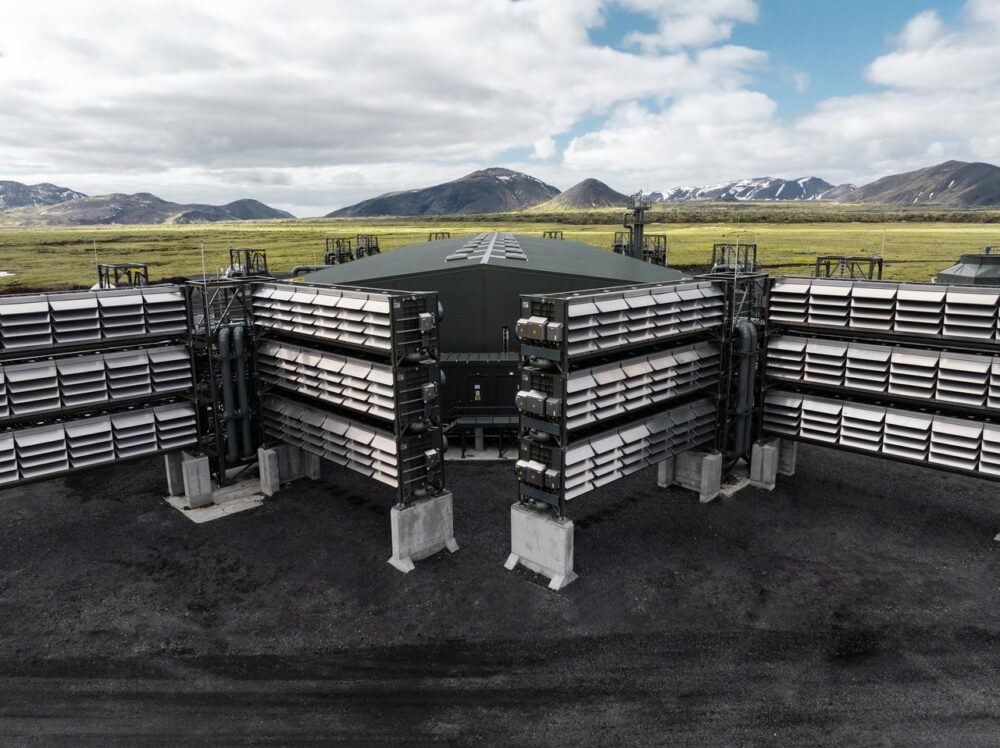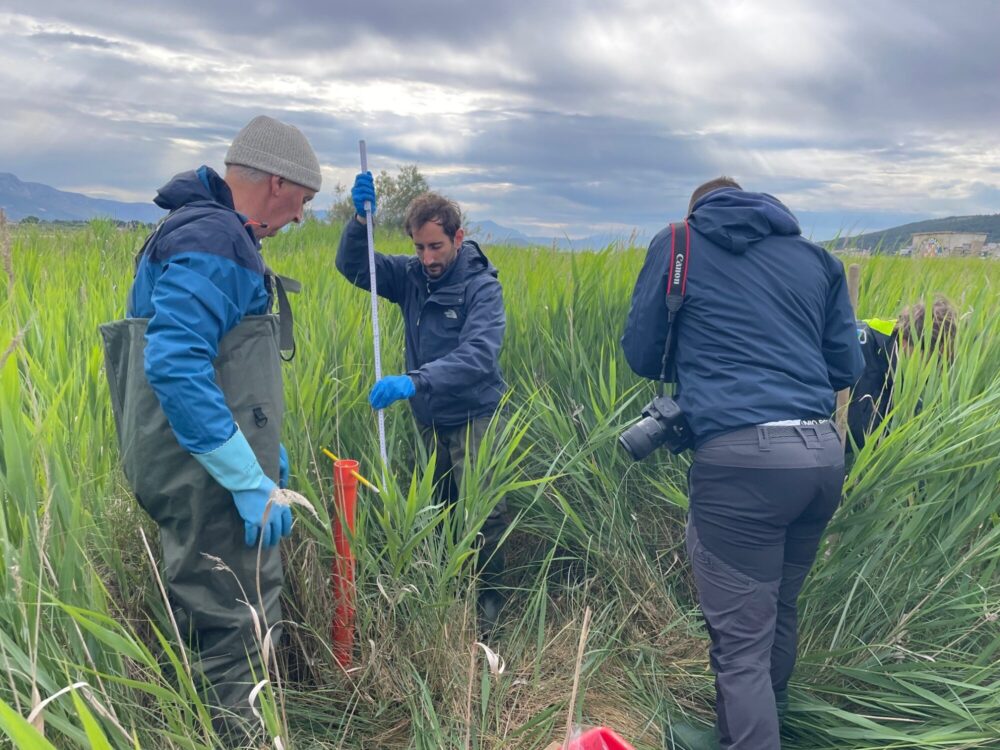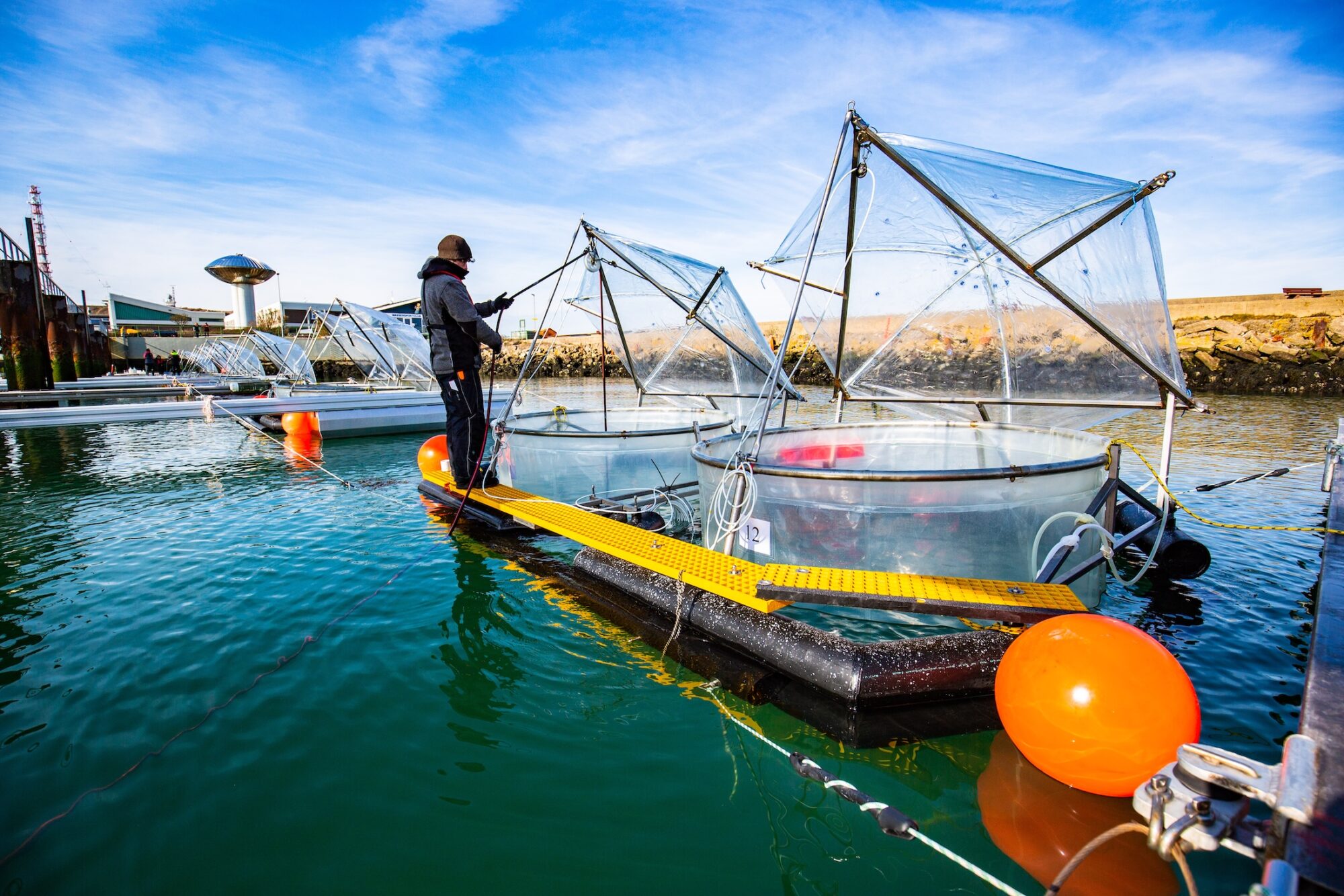Can we tap the ocean’s power to capture carbon?
The oceans have to play a role in helping humanity remove carbon dioxide from the atmosphere to curb dangerous climate warming. But are we ready to scale up the technologies that will do the job?
The answer, according to an expert group reporting to the European Union, is no.
At least, not yet – not until there are measures in place to ensure these technologies, called marine carbon dioxide removal technologies, are doing what they are supposed to do and won’t do more harm than good.
Marine carbon dioxide removal technologies build on the ocean’s ability to absorb carbon. They can be biological, like encouraging the growth of plankton or seaweed that take up carbon dioxide as they grow, or they can be chemical or physical, such as directly removing carbon dioxide from the ocean.
After these technologies remove the carbon from the air, it can be stored at the ocean floor and sediments, or the deep ocean, or in geological reservoirs or long-lived products (see fact box).
Marine Carbon Dixode Removal Technologies
Two main categories are currently being explored to remove carbon dioxide from the ocean.
Biotic methods rely on photosynthesis, in which marine organisms, particularly phytoplankton, take up CO2 and convert it into biomass. When these organisms die, some of their organic matter sinks, carrying the carbon with it. This is a process that removes carbon from the atmosphere and transports it to the ocean’s depths, where it is stored as part of long-term carbon sequestration.
Six approaches fall under this category:
- Preexisting marine biomass removal, where naturally occurring marine algal biomass can be transferred to the deep ocean where the biomass and degradation products can be stored out of contact with the atmosphere on climate-relevant timescales (>100 years). A key candidate for this is Sargassum, a genus of free-floating, fast-growing macroalgae, that grows in temperate and tropical seas.
- Marine biomass cultivation, where marine macroalgae (kelp and seaweed) are intentionally cultivated to take up CO2 through photosynthesis. They are then cultivated and sunk to the deep ocean.
- Marine bioproducts for durable products and energy, where seaweed can be made into bioplastics and construction composites. Seaweed can also be converted into bioenergy where the CO2 produced can be captured and stored underground.
- Ocean fertilization is where nutrients are supplied to phytoplankton to enhance their growth and thus their CO2 uptake. This carbon is sequestered in the deep ocean when the phytoplankton die and sink.
- Artificial upwelling relies on the ocean’s natural nutrient cycles by pumping cold, nutrient-rich deep water to the surface to stimulate phytoplankton growth. This approach is not technically feasible yet.
- Coastal blue carbon management involves replanting and restoring coastal vegetated ecosystems such as mangroves, salt marshes and sea grasses.
Geochemical methods capture and store atmospheric CO2 through non-biologically mediated chemical processes. These methods are inspired by natural carbon cycles and chemical weathering of rocks.
- Ocean alkalinity enhancement uses different methods to enhance the ocean’s capacity to take up CO2 from the atmosphere by changing the dissolved CO2 into bicarbonates or carbonates. This allows the ocean to take up even more CO2 from the air.
- Artificial downwelling creates a downward flow of upper ocean waters to enhance the transport of both dissolved and particulate carbon deeper into the ocean to enhance long-term storage
- Ocean carbon removal extracts carbon from seawater in a designated facility by using electrochemistry powered by renewable energy. This CO2 is stored underground in geological formations, mineralized into stable carbonate rocks, or used in products with a long lifetime.
(excerpted from Monitoring, Reporting and Verification for Marine Carbon Dioxide Removal, Future Science Brief No 13, Nov. 2025)
See also: National Academies of Sciences, Engineering, and Medicine. 2022. A Research Strategy for Ocean-based Carbon Dioxide Removal and Sequestration. Washington, DC: The National Academies Press. https://doi.org/10.17226/26278.

Schematic overview of marine carbon dioxide removal (mCDR) methods included in this Future Science Brief from the European Marine Board. See the fact box for a description of each one. Graphic: Rita Erven, GEOMAR (CC BY 4.0).
“This is about safeguarding the oceans for a common good. The oceans can be part of the climate solution, but we need to strengthen the way we safeguard them before we scale things up,” said Helene Muri, a senior researcher at NILU and the Norwegian University of Science and Technology.
Muri was chair of an expert group commissioned by the European Marine Board to study the issue.
European Marine Board
The European Marine Board (EMB) is the leading European think tank in marine science policy. It provides a platform to advance marine research and to bridge the gap between science and policy.
The board is a unique strategic pan-European Forum for seas and ocean research and technology. It provides a strategic forum to develop marine research foresight, initiate state-of-the-art analyses and translate these into clear policy recommendations to European institutions as well as national governments.
Their new report, “Monitoring, Reporting and Verification for Marine Carbon Dioxide Removal,” is released in conjunction with the UN’s climate change meeting, COP30, being held in Brazil.
Emissions cuts first priority
The Earth is getting warmer, and much faster than the nations of the world had hoped a decade ago when they pledged in Paris to limit global temperature increases to 1.5°C above “pre-industrial levels”.
We know how to cut emissions, and we have lots of methods that work. That has to take top priority.
In his opening remarks to the COP30 Leaders’ Summit on November 6, UN General Secretary António Guterres confronted his audience with the urgency of the situation.
“Science now tells us that a temporary overshoot beyond the 1.5°C limit – starting at the latest in the early 2030s – is inevitable,” he said. “Let us be clear: the 1.5°C limit is a red line for humanity. It must be kept within reach. And scientists also tell us that this is still possible.”
The European Marine Board report underscores the need to act now with tools that are known to work – namely cutting emissions.
“We know how to cut emissions, and we have lots of methods that work,” Muri said. “That has to take top priority.”
Net zero and residual carbon
So why talk about removing carbon dioxide from the ocean at all, if the goal is to cut carbon dioxide emissions to zero?
None of these methods are mature to use if you cannot verify impacts or where the carbon goes, or how long it stays away from the atmosphere.
Here’s where reality comes in. Cutting emissions from burning fossil fuels for energy, while difficult, is doable because we have alternative energy sources, such as solar and wind energy, that can do the job.
However, some products and technologies we rely on are difficult to make carbon free. There’s plenty of research being done to reduce carbon emissions from air travel, for example, but carbon-free flight has proved elusive. And even as people are encouraged to fly less, there are still times when air travel is the only option.
Societies across the globe need to achieve something called net zero by 2050. That’s when all the CO2 emissions are zeroed out by removing the exact same amount of emissions.
Reaching the 1.5°C level requires reaching net negative emissions. That’s where societies cut all emissions that are possible to cut but then find ways to compensate for “residual” emissions, those that simply can’t be eliminated.
“We must have a net removal of carbon dioxide from the atmosphere to get to 1.5°C and that means that you will likely have some residual emissions from some sectors, such as shipping and aviation, and some industries,” Muri said. “And then you will have relatively large scale removal of carbon dioxide from the atmosphere as well, so that the net is at about between 5 to 10 gigatons of CO2 removed per year towards the end of the century, according to scenarios by the IPCC.”
To put those numbers into context: Total global CO2 emissions were 42.4 gigatons of CO2 in 2024, according to CICERO, the Oslo-based Center for International Climate Research.
Land-based technologies to remove this “residual” carbon are already underway – the main method is through afforestation. Another example are the Climeworks direct air capture plants in Iceland, where giant fans suck air through a filter that removes the CO2, which is then mixed with water and injected into bedrock, where it turns to stone (see photo below).

The land -based Mammoth Plant in Iceland is Climeworks’ second commercial direct air capture and sequestration (DAC+S) plant and is about ten times bigger than its predecessor plant, Orca. Image courtesy of Climeworks © OZZO Photography
There have been quite a few field tests of different kinds of marine carbon dioxide removal, but many of the technologies remain in their infancy. Others are gaining more traction. Here is why setting standards now, for monitoring, reporting and verifying what is being done, is important.
The challenge
Some marine based approaches to removing carbon dioxide from the ocean are similar to land-based mitigation options.
If you’re storing carbon in the ocean, in some form or another, not in a geological reservoir, it’s a lot harder to to govern it and also monitor it. The ocean doesn’t stay put.
Planting lots of trees or protecting rainforests because they soak up carbon are two examples of land-based mitigation. In the same way, some marine carbon dioxide removal technologies involve protecting and enhancing coastal areas, such as mangrove swamps.

Here, researchers take samples of sediments and vegetation for carbon sequestration analysis in the Pantan Special Reserve salt marshes (Croatia) under the auspices of the Interreg Adriatic-Ionian project Cradles (Creating Resilient Areas to Develop Lifecycles and Ecosystems Services).Photo: Sanja Matić-Skoko, IZOR.
Other approaches are more interventionist, such as fertilizing the ocean with iron or other nutrients to fuel plankton growth. These huge plankton blooms absorb carbon dioxide. When they die, they carry the carbon into the deep ocean, far from the atmosphere.
That’s the theory, at least. The problem, Muri says, is knowing how well these different technologies actually work.
For example, how does a company actually prove how much excess carbon dioxide is being removed by the technology in question?
If we send carbon to the deep ocean, do we know how long it will stay there?
And while there are a number of different government and international agencies, along with international treaties and protocols, which ones should take the lead role? And how do they verify what is actually being done?
Ideally, “you monitor what is the background state of carbon (in the ocean) and then you implement your project and make sure that you have removed carbon from the atmosphere. And you try to monitor how much carbon that you have removed and how long it is staying away from the atmosphere. And then you report that to some independent party and then it verifies that what you’re saying is correct,” Muri said.
The twist?
“If you’re storing it in the ocean, in some form or another, not in a geological reservoir, it’s a lot harder to to govern it and also monitor it. The ocean doesn’t stay put,” she said.
Credits and environmental impacts
Addressing these issues will be critical as technologies mature to the point where they are used by governments or companies to claim credit for removing carbon dioxide. Some companies have already begun to do so, Muri says.
“None of these methods are mature to use if you cannot verify impacts or where the carbon goes, or how long it stays away from the atmosphere,” Muri said.
“If we want to be serious about figuring out if you can do marine carbon dioxide removal in responsible ways that can make meaningful contributions, then we have to get serious about the monitoring, reporting and verification aspects,” she added.
“The credit part of it also has to work right. You have to have reliable and transparent and scientifically defensible crediting systems.”
Reporting will also have to include any environmental impacts, Muri said.
The way forward
In spite of the many uncertainties surrounding marine carbon dioxide removal, “all future scenarios are showing us that we will need carbon dioxide removal in order to reach our most ambitious temperature goal,” Muri said.
That’s the conclusion of the IPCC from any number of the organization’s reports, but particularly in a special report from 2018 on Global Warming of 1.5°C.
“We don’t know all the threats of these immature methods yet, but it’s a bit hard to just take them off the table because they’re uncomfortable to think about,” she said.
Nevertheless, marine carbon dioxide removal will not be a “miracle ocean fix to climate change,” she said. “Some people are really hoping to find an answer in the ocean, but in our opinion, we’re not there yet.”
“And there’s a question of whether it can be a scientifically governed climate solution, and we don’t have the answer to that yet. But if we want to go in that direction, then we need to clear up all of these standards and establish these properly before we can scale things up,” she said.
Reference:
Muri, H., Sulpis, O., Argüello, G., Baker, C. A., Böettcher, M., García-Ibáñez, M. I., Kuliński, K., Landolfi, A., Landschützer, P., McGovern, E., Ninčević Gladan, Ž., Oschlies, A., Yfantis, E. A. (2025) Monitoring, Reporting and Verification for Marine Carbon Dioxide Removal. Muñiz Piniella, A., Rodríguez Perez, A., Kellett, P., Alexander, B., Bayo Ruiz, F., Heymans, J. J. [Eds.] Future Science Brief N°. 13 of the European Marine Board, Ostend, Belgium. ISSN: 2593-5232.ISBN: 9789464206388. DOI: https://doi.org/10.5281/zenodo.17435116






